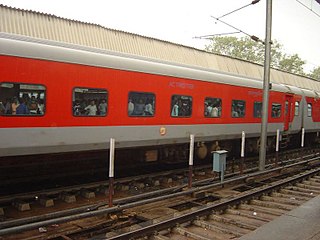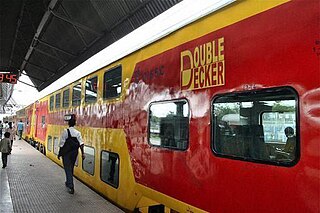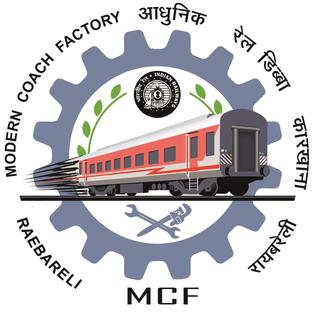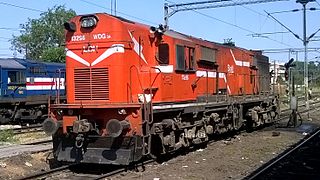
Rail transport in India consists of primarily of passenger and freight shipments along an integrated rail network. Indian Railways (IR), a statutory body under the ownership of the Ministry of Railways of the Government of India, operates India's national railway system. It is the primary owner and operator of rail operations throughout the country including suburban rail in major metros.

A bilevel car or double-decker coach is a type of rail car that has two levels of passenger accommodation as opposed to one, increasing passenger capacity.

The Rajdhani Express is a series of passenger train services in India operated by Indian Railways connecting the national capital New Delhi with the capitals or the largest cities of various states. Rajdhani, derived from the Sanskrit means "capital". Introduced in 1969, the trains are amongst the premium services operated by Indian Railways and regularly get a higher priority on the railway network.

The railway track or permanent way is the elements of railway lines: generally the pairs of rails typically laid on the sleepers or ties embedded in ballast, intended to carry the ordinary trains of a railway. It is described as a permanent way because, in the earlier days of railway construction, contractors often laid a temporary track to transport spoil and materials about the site; when this work was substantially completed, the temporary track was taken up and the permanent way installed.

Indian Railways (IR) is a statutory body under the ownership of the Ministry of Railways of the Government of India that operates India's national railway system. As of 2023, it manages the fourth largest national railway system by size with a running track length of 104,647 km (65,025 mi) and route length of 68,426 km (42,518 mi) of which 60,451 km (37,563 mi) is electrified. With more than 1.2 million employees, it is the world's ninth-largest employer and India's second largest employer.
Indian Railways operates India's railway system and comes under the purview of the Ministry of Railways of Government of India. As of 2023, it maintains over 108,706 km (67,547 mi) of tracks and operates over 13,000 trains daily with a fleet of 14,800 locomotives. The railways primarily operates a fleet of electric and diesel locomotives along with a few compressed natural gas (CNG) locomotives. Steam locomotives are operated on mountain railways and on heritage trains.

The Indian locomotive class WDP-4 is a passenger-hauling diesel-electric locomotive with AC electric transmission designed by General Motors Electro-Motive Division and built by both GM-EMD and under license by Banaras Locomotive Works (BLW) of Varanasi, India for Indian Railways as the classes WDP4, WDP4B and WDP4D. The GT46PAC is a passenger version of the previous Indian Railways EMD GT46MAC freight locomotive. The locomotive has a 16-cylinder 710G3B diesel engine and is one of the fastest diesel-electric locomotives in service in Indian Railways.

The 12385 / 12386 Howrah – Dhanbad Double Decker Express was an air conditioned superfast double-decker train of Indian Railways that use to connect the capital city of West Bengal, Kolkata to the city of Dhanbad, also known as the Coal Capital of India, in Jharkhand. It was the first air conditioned double-decker train of Indian Railways.

Modern Coach Factory, Raebareli or MCF Raebareli is a rail coach manufacturing unit of the Indian Railways at Lalganj near Raebareli in Uttar Pradesh. The factory is one of the coach production unit of Indian Railways besides the Integral Coach Factory at Perambur, Chennai in Tamil Nadu, Rail Coach Factory at Kapurthala in Punjab, Marathwada Rail Coach Factory in Latur, Maharashtra and Rail Coach Factory at Sonipat, Haryana. The factory was inaugurated on 7 November 2012. MCF Raebareli is one of the most advanced coach manufacturing unit of the world it is equipped with the many state of the art industrial robots and machines, on result making it require less manpower than other coach manufacturing units of Indian Railways.

The Indian locomotive class WAG-12B is a class of 25 kV AC electric locomotives that was developed in 2017 by Alstom with technological collaboration with Indian Railways. The model name stands for wide gauge(W), Alternating Current (A), Goods traffic (G) locomotive-12 . They entered trial service in 2019. A total of 410 WAG-12B have been built at Electric Locomotive Factory, Madhepura, Bihar, India.

The 12583 / 12584 Lucknow Jn.–Anand Vihar Terminal AC Double Decker Express is an Indian Railways train running between Lucknow Junction and Anand Vihar Terminal. It is the ninth double decker train in India and is the first such service for the state of Uttar Pradesh. The train operates four days a week on Tuesdays, Thursdays, Fridays and Sundays from both ends. After Lucknow Mail, Lucknow–New Delhi AC Superfast Express, Lucknow Swarna Shatabdi Express and Gomti Express, it is the fifth dedicated train service between the national capital and the state capital of Uttar Pradesh. The other train service is by IRCTC by the name of Lucknow - New Delhi Tejas Express.

Vande Bharat Express is a medium-distance superfast express service operated by Indian Railways. It is a reserved, air-conditioned chair car service connecting cities that are less than 800 km (500 mi) apart or take less than ten hours to travel with existing services. The train entered commercial service on 15 February 2019.

The Indian locomotive class WDG-3A is a class of diesel-electric locomotive that was developed in 1994 by Banaras Locomotive Works (BLW),Varanasi for Indian Railways. The model name stands for broad-gauge (W), Diesel (D), Goods traffic (G) engine, 3,100 hp (3A) locomotive. They entered service on 18 July 1995. A total of 1,164 WDG-3A units were built between 1994 and 2015 at BLW, Varanasi with a few units being produced by Diesel Loco Modernisation Works (DLMW) and Parel Workshop.

The Indian locomotive class WCG-2 is a class of 1.5 kV DC electric locomotives that was developed in the late 1960s by Research Design and Standards Organisation (RDSO) and Chittaranjan Locomotive Works (CLW) for Indian Railways. The model name stands for broad gauge (W), DC Current (C), Goods traffic (G) engine, 2nd generation (2). They entered service in February 1971. A total of 57 WCG-2 were built at CLW between 1978 and 1983, which made them the most numerous class of DC electric locomotive.

The Indian locomotive class YDM-5 is a class of diesel-electric locomotive that was developed in 1964 by General Motors (GM-EMD) for Indian Railways. The model name stands for Metre gauge (Y), Diesel (D), Mixed traffic (M) engine, 5th generation (5). They entered service in 1964. A total of 25 YDM-5 locomotives was built between 1963 and 1964.
The Indian locomotive class YDM-3 is a class of diesel-electric locomotive that was developed in 1964 by GM-EMD for Indian Railways. The model name stands for Metre gauge (Y), Diesel (D), Mixed traffic (M) engine, 3rd generation (3). They entered service in 1962. A total of 30 YDM-3 locomotives was built between 1961 and 1962.
The Indian locomotive class WCM-2 is a class of 1.5 kV DC electric locomotives that was developed in 1956 by Vulcan Foundry and English Electric for Indian Railways. The model name stands for broad gauge (W), Direct Current (C), Mixed traffic (M) engine, 2nd generation (2). They entered service in 1957. A total of 12 WCM-2 locomotives were built in England between 1956 and 1957.
The Indian locomotive class WCM-3 is a class of 1.5 kV DC electric locomotives that was developed in 1958 by Hitachi for Indian Railways. The model name stands for broad gauge (W), Direct Current (C), Mixed traffic (M) engine, 3rd generation (3). They entered service in 1958. A total of 3 WCM-3 locomotives were built in Japan in 1958.
The WDM-2G is a class of diesel electric genset locomotive used in Indian Railways. It is one of the rarest locomotives in India with only two units being produced by Patiala Locomotive Works (PLW). The locomotives were produced with an intention of being fuel efficient and to be used for light to medium duties such as short passenger runs along with occasional shunting. They are one of the only two classes of locomotives in India to feature multiple prime movers, the other example being WDS-6G, which was designed solely for shunting. They have a rated power of 2,400 HP.
The Indian locomotive class WAP-3 was a class of 25 kV AC electric locomotives that was designed by Research Design and Standards Organization (RDSO) and Chittaranjan Locomotive Works (CLW) for Indian Railways in 1987. The model name stands for Broad gauge (W), AC Current (A), Passenger traffic (P) locomotive, 3rd generation (3). They entered service in 1988. They were the faster variant of the previous WAP-1 class. A total of 9 WAP-3 were converted from existing WAP-1 units at CLW between 1987 and 1988. All locomotives were now withdrawn from service and converted back to WAP-1.














